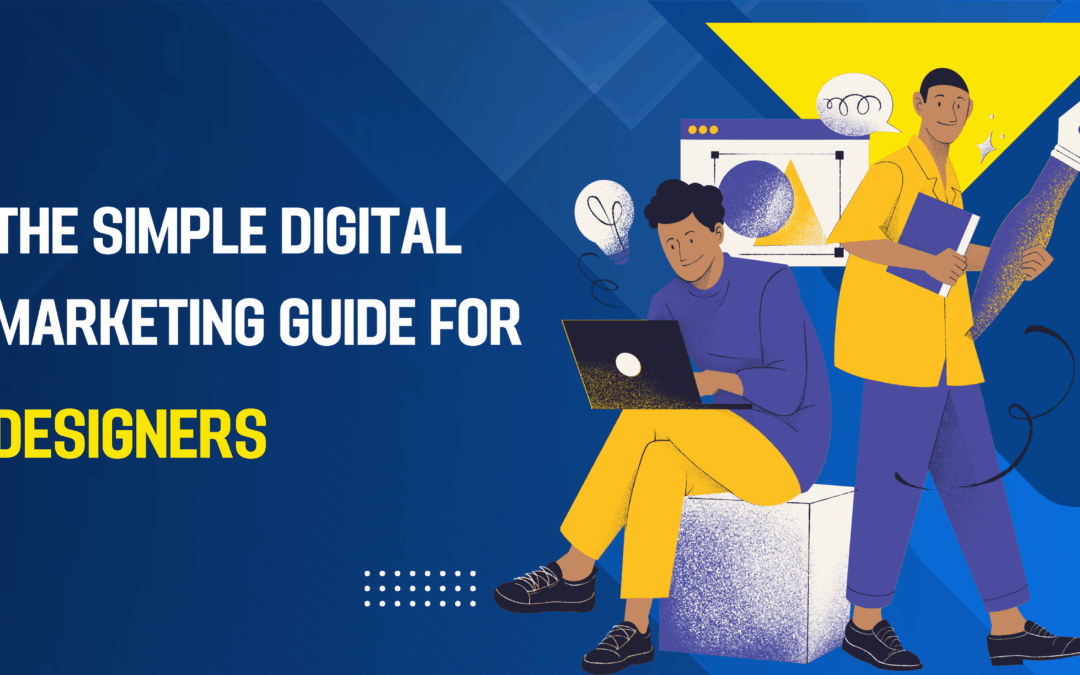Introduction Digital Marketing Guide for Designers: It’s Not Just About a Pretty Portfolio.
Being a talented designer is not enough. To succeed, you must also be a strategic marketer. This guide moves beyond basic advice, providing a clear, actionable blueprint to leverage digital marketing and make your design services irresistible to your ideal clients. We’ll focus on strategies that not only rank on Google but also provide genuine value, answering the questions your potential clients are already asking.
1. Foundational Strategy: Define Your Digital Blueprint
Before you post a single tweet or write a blog post, you must have a strategy. This foundation ensures all your marketing efforts work together.
A. Niche Down to Scale Up
Specialization is your greatest marketing weapon. Instead of being a “graphic designer,” become an expert for a specific audience.
- Example: Instead of “I design logos,” try “I craft memorable brand identities for sustainable consumer packaged goods (CPG) startups.” This specificity makes messaging, targeting, and client attraction infinitely easier.
- Actionable Tip: Ask yourself: “What industry do I enjoy? What type of client has budgets I need? What specific design problems do I solve best?”
B. Craft a Compelling Unique Value Proposition (UVP)
Your UVP is a clear statement that explains how you solve your client’s pain points, the specific benefits you deliver, and why you are uniquely qualified.
- Weak UVP: “We provide high-quality design services.”
- Strong, Client-Centric UVP: “We help B2B SaaS companies convert more users through intuitive UI/UX design and data-driven landing pages. See how we increased Acme Corp’s sign-ups by 27%.”
- Actionable Tip: Frame your UVP around the client’s outcome, not your output.
2. Content & SEO: Become the Answer Your Clients Are Searching For
This is a long-term strategy to build authority and attract organic traffic.
A. The Power of Portfolio Case Studies
Your portfolio shouldn’t just be an image gallery. Transform it into your strongest sales tool with detailed case studies. This is critical for ranking for terms like “[Your Niche] design portfolio” or “redesign examples.”
- Example Structure for SEO & Users:
- The Challenge: “A rising eco-friendly shoe brand needed a packaging design that stood out on shelves and reflected their sustainable values.” (Uses keywords naturally).
- Our Process: Briefly show mood boards, sketches, and iterations. This builds trust and showcases expertise.
- The Solution: Present the final stunning visuals.
- The Results: “The new design contributed to a 15% increase in in-store pick-up and received praise for its innovative use of recycled materials.” Quantifiable results are SEO gold and client magnets.
B. Blog with Strategic Intent
Don’t just blog about design trends for other designers. Blog for your clients. Answer their questions and address their pain points.
- Keyword-Focused Topic Ideas:
- “How Much Does a Professional Website Redesign Cost in 2024?” (Targets high-intent search queries).
- “5 Signs Your Brand Identity Is Hurting Your Sales (And How to Fix It)”.
- “A Small Business Owner’s Guide to Working with a Graphic Designer.”
- Actionable Tip: Use free tools like Google Keyword Planner or AnswerThePublic to find questions your ideal clients are asking.
3. Social Media & Community: Show Your Process, Not Just Your Perfection
Social platforms are for building relationships, not just broadcasting work.
A. Platform-Specific Strategies:
- Instagram & TikTok: Use Reels and Shorts to show behind-the-scenes content. A time-lapse of you designing a logo, a quick tip on choosing fonts, or a tour of your workspace. Use hashtags like #GraphicDesignTips, #BrandDesign, #WomenInDesign, #[YourCity]Designer..
- LinkedIn (Ideal for B2B): Publish your case studies and write articles about design’s role in business growth. Connect with founders, marketing managers, and CEOs. Example Post Headline: “How Investing in UX Design Saved Our Client $50k in Customer Support Costs.”
B. Engage Authentically
Comment on other industry professionals’ posts, join design and business groups, and share valuable insights without always asking for something in return.
4. Technical & Paid Strategies: Accelerate Your Visibility
A. Local SEO for Designers
If you serve local clients, this is non-negotiable.
- Google Business Profile: Create and optimize your listing with your category, photos, website link, and client reviews.
- Local Keywords: Use phrases like “web designer near me,” “Milwaukee branding agency,” or “logo designer in Seattle” on your website and content.
B. Smart Paid Advertising
A small budget can yield big results with precise targeting.
- Google Ads: Bid on high-intent keywords like “hire a packaging designer” or “website redesign services.”
- Social Media Ads: Use Facebook/Instagram ads to promote your best case study to a highly targeted audience (e.g., “Show this case study to people who hold the ‘Marketing Director’ title and work in the SaaS industry”).
5. Conversion Optimization: Turn Visitors into Clients
A visitor means nothing unless they take action.
- Clear Calls-to-Action (CTAs): Every page should have a purpose. Use CTAs like “View Our Full Case Study,” “Get a Free Quote,” or “Book a Discovery Call.”
- Simplify Contact: Use a simple contact form and consider embedding a scheduling tool like Calendly or Acuity to allow clients to book a call instantly without email tag.
- Collect Testimonials: Social proof is powerful. Feature short videos or written testimonials prominently on your site. Example: “Working with [Agency Name] transformed our website. The process was smooth, and the results exceeded our expectations.” – Jane Doe, CEO of Startup X.
Conclusion: Consistency is Key
The key is to provide consistent value. Choose one or two strategies from this guide—like perfecting your case studies and engaging on LinkedIn—and execute them consistently. By blending your artistic talent with strategic marketing, you’ll build a resilient and thriving design business that attracts clients you love working with.
Ready to transform your design business? Start by auditing your website: does it feature results-driven case studies, and is it easy for potential clients to contact you?

